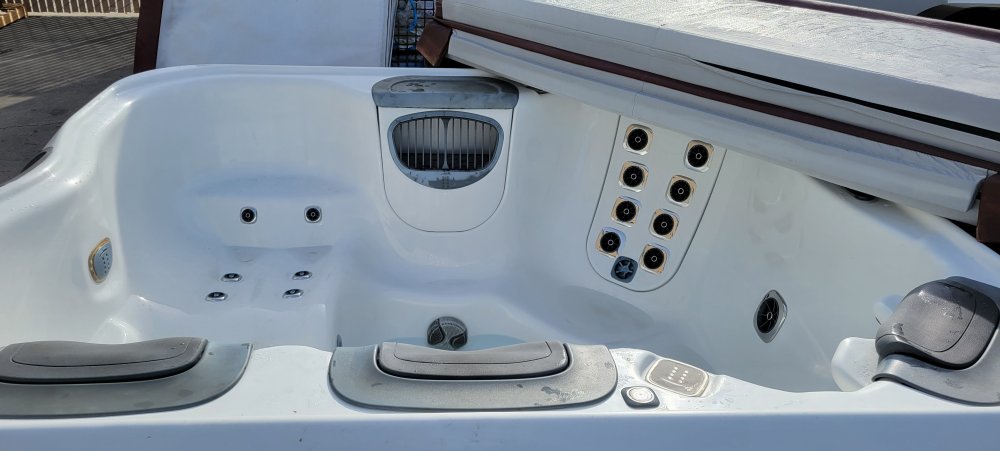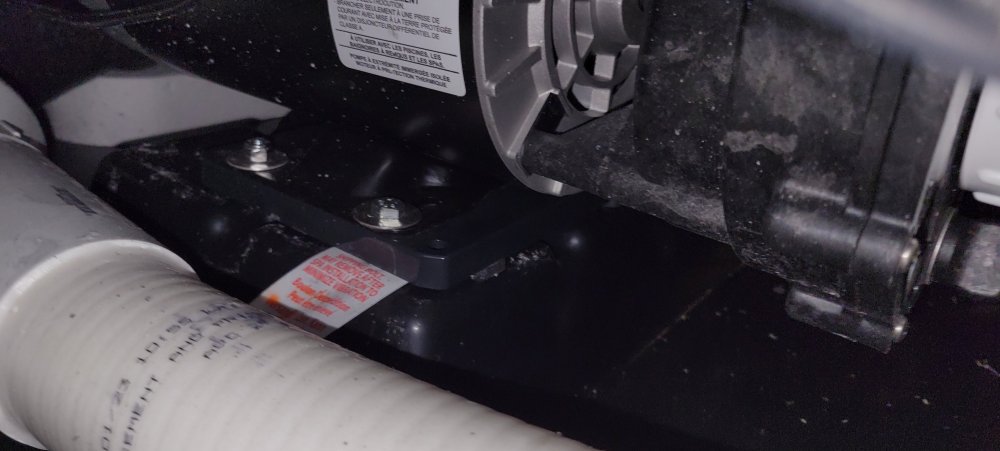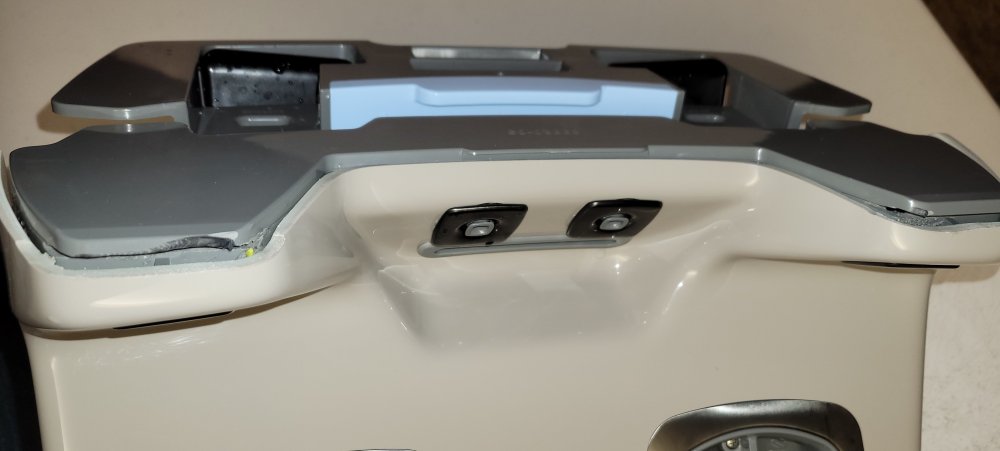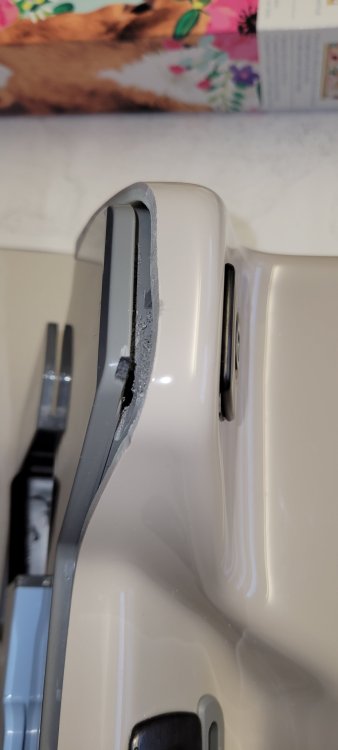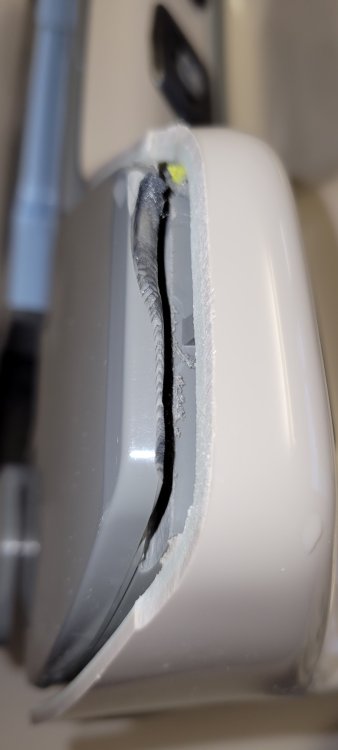-
Posts
28 -
Joined
-
Last visited
Profile Information
-
Gender
Male
-
Location
East SF Bay Area
-
Gender
Male
Recent Profile Visitors
386 profile views
Davekro's Achievements

Junior Member (2/5)
0
Reputation
-
When I have been adding small amounts of Chlorine (1-3oz) or 31.45 % Muriatic acid (< 1oz), I have been adding them into a bucket of ≈2 gallons of hot tub water, mixing, then pouring slowly over jets on low. Is this overly cautious? Is it fine to just slowly pour these chemicals directly from the small measuring cup, dispersing over a wide area slowly w/o splashing?
-
I don't recall getting answers to most of that inquiry. But I read a post from JoyfulNoise over on the TFP forum that said that the EOS system was the correct way to do Ozone. That it running with its chamber mixed ozone was more efficient and did not create near the ozone cloud under the cover that a standard ozone generator does. I ended up with the floor model A6L I had been planning to get. It had EOS, but not a circ. pump. I think I would have preferred a circ. pump, but there is really a split opinion on them. Although, most assume the 'circ. pump' is a low wattage pump running 24/7. As you know,that is not what Bullfrog uses, so I'm still not sure if getting Bullfrog's Circ. pump where you set its run times for however long you want, really fits the situation most circ. pump naysayers refer to. If I was 'ordering a Bullfrog, I'd be leaning towards a circ pump. I don't recall the added price for it. If it was close to $500, then yes. I the option was $1000-$1500, maybe not.
-
I was looking at my 5-week-old Bullfrog A6L's three EOS Ozonator System components today, Ozone Generator $392, Ozone Mixing Chamber, and Carbon filter. The carbon filter says to mark the date put in use and replace in two years. The new Bullfrog brand EOS carbon filter costs $88. My reading says that carbon absorbs Ozone (O3). There does not apear to be any other special ingredients required, so I will just replace it with a generic carbon filter. I'm not sure which types of activated carbon used in water treatment – Granular Activated Carbon (GAC) and Powdered Activated Carbon (PAC), would be best for this application. The main difference between GAC and PAC is their particle size. GAC has a larger particle size than the PAC and thus larger surface area. I'd guess the granular (GAC), but I'll cut open the old filter in 2 years to see the texture of the charcoal in the Bullfrog OEM filter when it is time to replace it.
-
waterbear, Thank you for moving my post to the water chemistry thread.
- 4 replies
-
- antihistamine
- bathtub chlorine test
-
(and 3 more)
Tagged with:
-
[Edit: My wife told me her Dr. said she had a skin ‘sensitivity’ to Bromine, not an ‘allergic reaction’. I have changed my references to ‘allergy/allergic’ to ‘skin sensitivity’. The link says that ‘skin sensitivity’ (irritant contact dermatitis) shows a reaction, rash, in 1–2 hours (which she had), whereas ‘allergic contact dermatitis’ is an immune system reaction that takes from 24 to 48 hours to show symptoms. The ‘skin sensitivity reaction’ was quite severe for her, so it is still a significant issue. This article talks about testing patches of skin on your arm, like a dermatologist would do. I’ll have her ask her Dr. if he/she can recommend a chlorine % solution to apply to her arm as a chlorine sensitivity test, rather than dunking her whole body in a bathtub of chlorinated water!] Before we go through the hassle of draining the tub and restarting with Chlorine as the sanitizer instead of Bromine, to see if Chlorine causes my wife no skin rashes, we want to fill the bathtub with hot water and simulate the chlorine water conditions that would be the same as if we convert the hot tub to chlorine. So here are our questions: 1) Is it common for some people to have a skin sensitivity reaction to Bromine, but NOT to Chlorine? What are the odds of this? (I’ll have her ask her Dr. about this too.) 2)How do I create a bathtub chlorine environment to match a hot tub's? [We may hold off for a possible arm skin patch test for chlorine if that is an option.] a) Would I need to reduce our tap water's 370 ppm TA (Total Alkalinity) down below 70 ppm (our hot tub's current TA is 40 ppm), then get the PH adjusted between 7.4- 7.7 before adding Chlorine to make the test valid as close as possible to apples to apples to the actual hot tub? b) How much of 7.5% chlorine to initially add to say ≈ 30 gallons of bath water to get an in-range chlorine level? c) I only have a Taylor K-2106 'Bromine' test kit. Is there a workaround test that will tell me the effective Chlorine level I need to measure? If I can't do that with my K-2106 kit/reagents, what reagents would I need to buy to perform a proper Chlorine level test for our experimental bathtub test? 3) Are people with similar Bromine sensitivity able to completely avoid skin irritant sensitivity reactions of rashes and bumps by simply taking Antihistamines like: 25mg Benadryl or 10mg Cetirizine HCI (Zyrtec or Amazon Generic), 10 mg Loratadine (Claritin or Amazon Generic)? If so, what doses and how long before and after? The Background: We purchased a brand-new Bullfrog A6L (310 gals) Hot tub with the only time it was filled was at OEM water test at the time of manufacture, three months prior. The tub was purged, water balanced, Bromine Reserve added, Chlorine Shock done, PH & Bromine levels have been kept in range. It causes my wife extreme rash and bumps, but I have no skin reactions at all. Our initial soak (103º F, PH 7.6, Ttl. Bromine 6ppm, TA 30 ppm) caused her an extreme skin irritation reaction where she had a rash and bumps on her trunk, arms and legs. I am using a Taylor K-2106 'Complete (FAS-DPD bromine)' test kit. She said the pain and itching for a week was worse than her prior bout of Covid. It kept her awake all night. A week and a half later we let the Total Bromine drop to zero, PH ≈7.6, TA 40ppm. The water temp was only at 93º F. The skin irritation reaction was nowhere near as strong, but she still felt it coming on 1–2 hours after her soak. She took one Zyrtec 10mg Cetirizine HCI Antihistamine at that time and for two days following and the rash dissipated. I have had no skin irritation reactions at all. Installation, thorough Purge and refill process: Three weeks ago, after the brand new hot tub was installed, I filled it (310 gals) and did a purge using AHH!some. Ran jets on high w/ air for 30-minutes, wiped away the green sludge from the shell above the water line and scooped a few small patches from the water. I then removed the four Bullfrog JetPaks and cleaned the green from them that was at the waterline. As an extra precaution, I then ran the jets on high for a second 30-minute period. There was only a small amount of green residue to wipe away this time. I then sprayed ≈ 50 gallons of water into the tub via each jet to rinse any lingering residue of green biofilm and AHH!some purge. I siphoned out then used a shop vac to completely drain the foot well as well as vacuuming each JetPak supply pipe and all the lowest fixed jets. I have rinsed the filter once per week. I am pretty sure we can rule out ‘hot tub folliculitis’. Thank you, Dave
- 4 replies
-
- antihistamine
- bathtub chlorine test
-
(and 3 more)
Tagged with:
-
IMHO, since I'm already ok bathing in Bromine, the misc. tiny amounts of stuff that our bodies shed or exude that the sanitizer and filter have not nullified or caught yet, I'm ok possibly bathing in a bit of 303 residue that may enter the tub's water. I get that things have a useful lifespan, but with a bit of occasional light cleaning and UV protectant a few times or more per year, the cover can at least have a better looking appearance and probably help it last to the longer end of it's useful life range. M a y b e 303 can partially stave off ozone and chemical impacts a bit. If Bullfrog suggests it, maybe so. Thanks for the saying to be conscious when opening the cover, so as not to inhale the ozone cloud!
- 13 replies
-
- warranty
- spa pillows
-
(and 1 more)
Tagged with:
-
@CanadianSpaTech , Huge thank you for the Bullfrog link on their recommendation on how to help extend the life of headrests! I would have never thought of 303 for the headrests. Actually, I never thought about any protectant for them. Starting out with a new hot tub, I'm glad to know there is something I can do to help the headrests maintain their surface look better for longer. I've had 303 on hand for many years, but actually using it does not pop into my head until I start to see some diminishing of the surfaces it's designed to protect. What a concept to use 303 from new to protect those materials and surfaces... before they start showing weathering! With the investment in this Bullfrog, at least for now ;o), I am motivated to use it on the cover, the headrests and the side panels. I was just wondering if 303 was also good to use on the Acrylic top surface. I quickly found the answer from 303 is "Do not use on acrylics." I see the recommendation for leaving cover off/open for at least 30-mins after adding Shock treatment. That seems very clear. But what about when you add a small amounts of chlorine bleach (1/4 oz - 2 oz) or Muriatic Acid 20% (1/4 oz - 2 oz) to adjust your PH (by say 0.1 to 0.4) & Bromine levels ( by say 1-4 ppm). Do these smaller doses create enough off gassing to warrant keeping the cover entirely off or one half open, for 1-2 mins, 3-5 mins, +/- 10 mins or more? I'd like to err on the side of caution to let the water have time to off gas in these smaller dose situations, but if in 1-2 mins no more off gassing will happen (with Acid or Bleach), then it would be easiest to close the top and not need to remember to come back in 'X' minutes to close the cover. That would usually mean I forget for longer and I pay to heat the air! ;o)
- 13 replies
-
- warranty
- spa pillows
-
(and 1 more)
Tagged with:
-
If you see a reference to this product not to be used in pools, would you post a link? I found nothing on the Klean-Strip product website ( https://kleanstrip.com/green/klean-strip-green-safer-muriatic-acid/ ). or anywhere on the container's label that says not to use in pools. I do not see a reference to pools at all. A search of the SDS for pool, hot tub, spa, gets no hits. The only knock I can find elsewhere is that the diluted (20% HCL/MA, 13º Baume) is that you just get a lower % of MA by volume than buying straight 31.45% by volume MA. I'll probably by 31.45% MA next time. Thank you.
-
@chuggers , What year, model, trim level is your Bullfrog? Bullfrog did design changes for the 2023 A Series tubs. This would have been the time to make improvements to the headrest issues, if B'frog cared to. Do you have the ABS plastic around the perimeter of the headrests (Standard headrests), or all one foam material (Premium headrest)? I posted a picture of a 2013 A6L (Standard Trim level) that I looked at when first shopping for a tub, showing discoloration, but no cracks or other deterioration. The second picture is the floor model 2023 A6L (Select) I recently had delivered, showing the Premium headrests. If you have time, would you be willing to post some pictures of your original deteriorated headrest(s) and the one replacement headrest? If I had the problem you describe and no remedy available from Bullfrog, I'd Google around to see if anybody, for any hot tub, has found a spray on material to re-coat old headrests to make them look better. Not just a surface 'treatment' like Armorall, but an actual coating that would be flexible and hold up to the 'chemical zone' between surface and cover. Best of Luck, Dave
- 13 replies
-
- warranty
- spa pillows
-
(and 1 more)
Tagged with:
-
Good idea. I wish I had thought of just backing them out a few turns! I removed them completely, which was a bit of a hassle by feel w/ a ratcheting 7/16" wrench. Parts of the large diameter hose (2 1/2"?) out of the left pump #1 was also vibrating against the plastic base. Lifted it a tad and it seemed not to vibrate onto the plastic base. I'll probably slip some thin pipe insulating foam between any spots that the large jet pump pipes are very near anything, while being careful not to put pressure on the hose(s) that might dislodge a pipe connection seal over time. I don't like that there are (insulated) wires and smaller (air?) hoses laying on top of at least pump #1. I don't know if the #1 jet pump normally gets very hot, but I will raise those from the surface with tie wraps or again a bit of foam between hose/wire surface and the body of the jet pump.
-
Biggen, I am having similar questions about how fast my Bromine level will drop from 24 ppm after adding the Sodium Bromide Reserve after fresh fill on my new hot tub, so your questions and waterbear's responses help. 🐵 I hope you do not have High TA (370 ppm) fresh fill water like I did. If you do, get some Muriatic Acid before starting your refill and balance task. I blew through most of my 1 lb canister of PH Decreaser (Sodium Bisulfate 93.2%) before switching to Muriatic acid to drop the PH down repeatedly after raising with aeration. I had no idea how soon I could retest the PH (how long it takes for the PH to settle at its low point after adding acid and whether that amount of time is different between powdered Sodium Bisulfate acid and liquid Muriatic Acid. I wanted to do as short of turn arounds as I could, to save time. Since I had no clue and could find no mention of it on this site or Google, I defaulted to waiting 30 mins after adding acid, until checking PH again, then starting the aeration, again for 30 mins. not knowing if 10 or 15 mins was plenty to raise the PH back up to 8.0. Good luck in your process. It is a learning experience.
-
"No, it is dependent on the TA for sodium bisulfate, Muriatic acid, or Sulfuric acid..." I know that a high TA level requires a much larger dose of acid of any kind. My question was not "how much" acid to use, but at a given TA level of the same water sample, for example 100 PPM, what dose of HCL effects the same PH change as say 2 oz of Sod. Bisulfate by volume? My shot at the math to convert from Chem Geek's 31.45% MA to 20% MA yields: "≈ 3.5 oz by volume of 20% MA." I won't swear to the accuracy of my conversion from 31.45% to 20% MA, but that was my question. Muriatic Acid to Sodium Bisulfate acid CHART.xlsx
-
The hum of just the one Jet Pump on low has quite a loud hum outside that carries through the house. The Jet pumps have a red and white tag on one of each pump's four mounting bolts. "Shipping Bolt. May Remove After Spa Installation to Minimize Vibration." I will remove those two bolts tomorrow. Curious if anyone has this very loud hum that resonates well into the opposite side of the house? Did you remove those two shipping bolts and notice a significantly lower sound from Pump #1 running on low for the circulation/filtration cycle? (I do not have the dedicated Circ. Pump.)
-
I got my new Bullfrog A6L Select two days ago and have a few questions for Bullfrog owners. The tub in not heated for use yet because I am in the long process to lower my tub's street water filled Total Alkalinity (TA) down from 370 PPM! So I have not been in the 60º water to 'feel' the jets, I am just observing them. 1) I never thought about it before, but it seems there is no option to run jets w/o AERATION. Am I missing something? Initially, I saw aeration only from the upper jets of each pack, then after repeatedly cycling both pumps rapidly through off, low, high, repeat, and using a plunger on the holes at the base of the two JetPaks closest to the pumps, it 'seems' aeration runs lower now, but not sure about the bottom most jets. I'll know more when it's heated and the chemicals are set up properly. 2) Specifically the new for 2023 Neck "Plus" JetPak (pictures attached)- When I removed the headrest covers to purge the hot tub, I noticed that the fronts were very roughly cut with slots like with a grinder wheel. The cuts did not match side to side, looked rough like the assembly line tech was NOT paying attention (built on a Friday/HIGH day ?), and the headrest covers do not snap over on these front extensions. What are these "manual cutouts" supposed to do??? With the pump on low, the one over the right shoulder sprays a disfigured stream, on high the stream is disfigured and very forceful. The one over the left shoulder on low squirts up and in all directions, on high it sprays in your face and all over. 3) When jets are manually turned on for use from the control display, the default setting Auto-shuts-off after 30 minutes. Is there somewhere in the settings to adjust the Auto-shut-off time? I looked and can not find it via the control panel. I ask because I need to run maximum aeration to increase PH so I can lower it with acid, REPEAT (many times) to lower extreme Total Alakalinity of 370 PPM to +/- 100 PPM. I learned something. 🐵 New for 2023, Bullfrogs have air bleed valves at the base of the front panel, so you no longer need to go inside and remove a hose on the actual pump(s) to bleed air out. The right air bleed connects to both Jet Pumps. I discovered that the left plug is for the dinky waterfall pump (bottom right side of cabinet). I initially thought there was a separate air bleed for each JET pump, so was confused why the left one had less flow and did not change with pump speed... well, Duh!





.thumb.jpg.d5aa7d4c648e7fa4fa7741d94f5b16a4.jpg)
